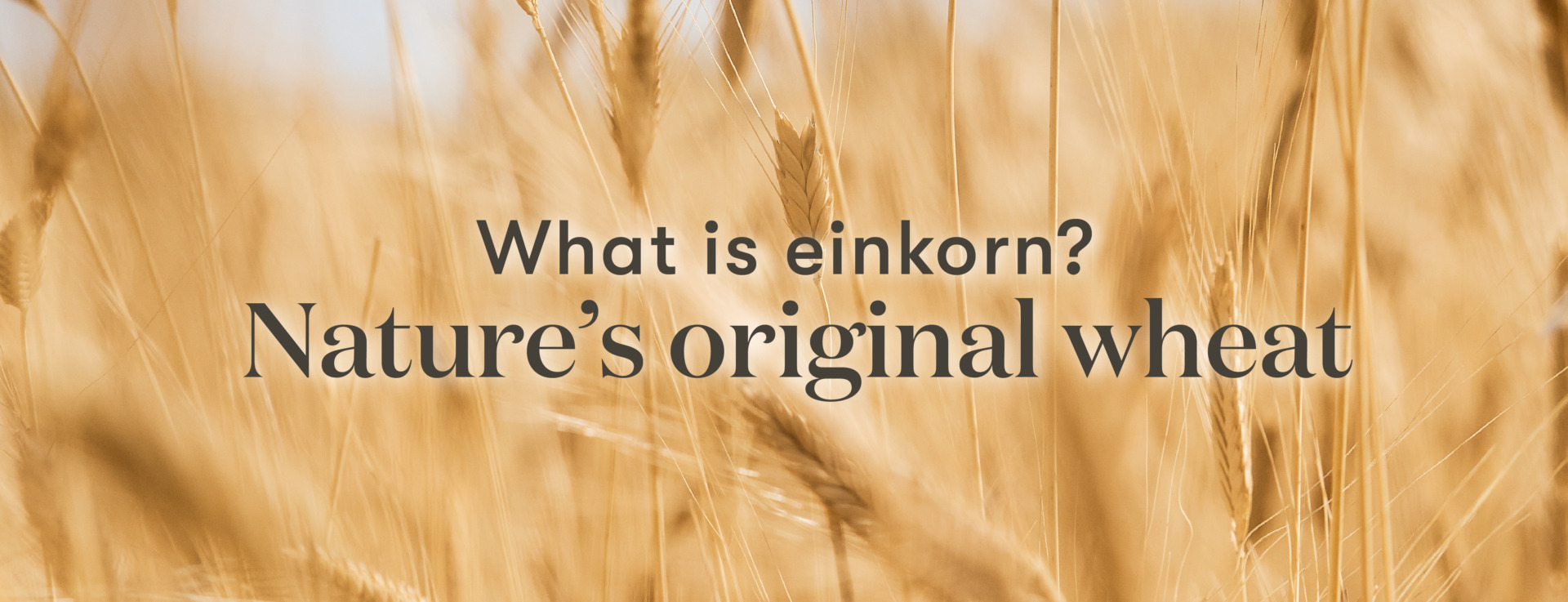What is einkorn? An introduction
Einkorn is a type of ancient wheat believed to be one of the oldest cultivated grains in the world. Known for its distinct, nutty flavor and for being easier to digest than modern wheat, this thousands-year-old superfood is making a comeback as a nutritious alternative to hybridized grains.
What’s so special about einkorn flour and why does it deserve a spot in your daily diet? Let’s find out.
Fun facts.
• Einkorn is one of the only unhybridized wheat we have left in the world.
• This ancient grain is less processed and contains only 14 chromosomes compared to modern wheat’s 42.
• It was found in the stomach of a 5,300-year-old frozen hunter in the Italian Alps—proof that einkorn has been part of people’s diets for at least that long.
• Its hull, or tough outer layer, protects the grain from fungi and insects, making it ideal for organic farming.
• Unlike many other grains, einkorn thrives in harsh conditions, thanks to the thick husk that surrounds its berries.
History of einkorn.
Einkorn is native to the Fertile Crescent, an area that makes up modern-day Iraq, Syria, and Turkey. It was first cultivated by the ancient Egyptians and later spread to other parts of the world, including Europe and the Mediterranean. While einkorn was once a staple in the ancient world, over the years it fell out of favor so much that only a few farmers still grow it today.
Why did this hardy, nutritious grain that was so popular for thousands of years become almost unheard of? The answer: modern wheat. Because modern wheat is easier to mill and provides at least three times the yield of einkorn, it quickly became the preferred grain for most farmers. But better yield doesn’t always mean better quality.
Nutritional benefits of this grain
What is the nutritional difference between einkorn and modern wheat? Compared to modern wheat, einkorn has more protein and vitamins. It’s also easier to digest, thanks to its lower number of chromosomes, which alters the gluten structure. The gluten in einkorn is different from the gluten in modern wheat, as it lacks the proteins that often trigger symptoms of gluten sensitivities. This means einkorn may be better tolerated by people who are sensitive to modern wheat; however, it’s not recommended for those with celiac disease and has yet to be recommended in a gluten-free diet.
Nutrition facts for einkorn vs. modern wheat
Looking for more specific nutritional information? See how this flour stacks up to modern, all-purpose flour below.
One serving (¼ cup) of einkorn flour contains:
• 110 calories
• 4 grams of protein
• 2 grams of dietary fiber
• 22 grams of carbohydrates
• 1 gram of fat (no trans fat or saturated fat)
One serving (¼ cup) of all-purpose flour contains:
• 109 calories
• 3 grams of protein
• 0.8 grams of dietary fiber
• 23 grams of carbohydrates
• 0.3 grams of fat (includes 0.1 gram of saturated fat)
Einkorn flour also contains slightly higher levels of calcium, iron, potassium, phosphorus, and vitamins A and B6 than wheat flour.
How to cook with einkorn.
You can substitute einkorn flour for all-purpose or whole-grain flour at a 1:1 ratio, making it easy to use in bread, pasta, and baked goods. However, because it isn’t as absorbent as all-purpose flour, you’ll want to reduce the liquids and baking times when using it in your recipes.
The simplest way to substitute einkorn flour for modern flour is to use a specialized cookbook, like Baking & Cooking with Einkorn by Heidi Ellis. Inside, you’ll find over 80 mouthwatering recipes, including this one for einkorn pumpkin cookies.
You can also enjoy this healthier grain in its whole, unmilled form. Dehulled einkorn berries are a tasty and nutritious snack on their own or as a crunchy topping in salads and breakfast bowls. Simply boil them with water on the stove, pop them in a frying pan with coconut oil, or cook them in a rice cooker or pressure cooker. Another reason to switch to this ancient grain? Learn how adding more fiber, protein, and whole grains to your diet can keep your immune system going strong.
Types of einkorn products.
If you’re looking to add einkorn to your diet, you have lots of options. In addition to flour and berries, there’s pasta, pancake mix, granola, and cereal—just to name a few!
Check out Young Living’s einkorn line to find a variety of pantry staples and snacks using this ancient grain.
Why you should try it.
While einkorn may not be as popular as it was thousands of years ago, it’s been steadily gaining favor as an alternative to traditional wheat. Whether you have wheat sensitivities or are simply looking to eat healthier, einkorn’s impressive nutrition profile and delightfully nutty taste make it worth trying out in the kitchen.






I’m looking for organic wheat germ or oil made from Einkorn wheat. Do you sell this product? Thnx